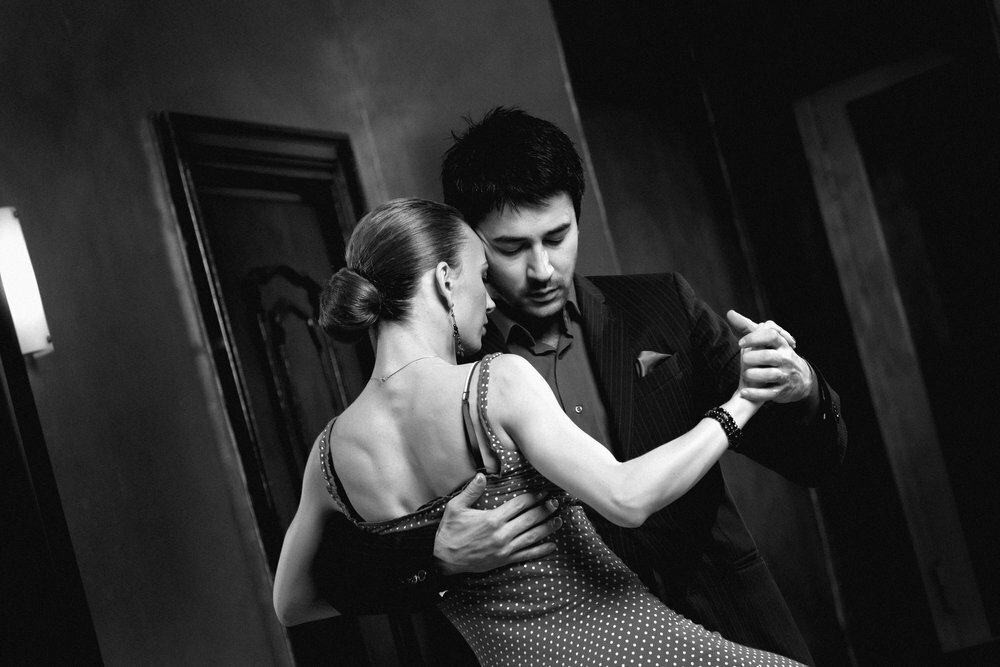When learning about tango, one might often read or hear about how communication is vital in making a connection with one's partner.
There are various resources out there that discuss this concept. But to the beginner, one might wonder: how does one communicate in tango when barely any words are spoken between partners?
To those who have been practicing tango for a long while,
communication in tango almost resembles intuition: one does not actively think about it but knows by heart how it transpires.
Those who have been frequenting practicas and milongas often possess this intrinsic understanding that subtle cues, certain steps, each movement of the hand or positioning of the foot articulate a specific message that both leader and follower wish to convey.
But for those who are just beginning to explore the dance, learning tango may be akin to learning another language.

Tango as a Language
Tango is associated with various words such as passion, energy, sensuality. Some may even say that tango is a connection or a relationship. But not too many associate tango with language, though some of its most basic principles point toward the act of weaving together a beautiful conversation.
According to The Language Journal,
“The Argentine Tango has been often called ‘a secret danced between two people.’ It is a dance not performed from the feet, the hips, or the arms but from the heart and soul. To the uninitiated,
Tango may seem to be simple because the dancers look like they are merely walking with their partners.
But to those who truly understand Argentine Tango,
they see it as an intimate form of communication. There is a language quietly spoken between the partners and generously shared with their audience in a most intimate way.”
But to speak tango fluently from the heart and soul, one must first have an elemental grasp of the language that will be used to convey these intimate sentiments. Though the above quote argues that tango is not performed from merely the movement of different body parts, one’s awareness of one’s body is, in fact, what makes up the smallest unit of tango as a language: its alphabet.
But what does this mean?
A post from the blog In Search of Tango provides an apt explanation:
“Like any language,
tango has its own alphabet, vocabulary, grammar and composition.
The body parts, including the head, the arms, the hands, the torso, the waist, the hips, the legs, and the feet, can be seen as the alphabet of tango. We use these elements to make movements or steps, which are the vocabulary of tango. Musicality and communication are like the grammar, according to which steps are improvised to form a dance. Choreography is the composition of the dance.”
While it is true that tango as a language is an intimate one, properly articulating this intimacy is just as important. To use another analogy: one cannot create a work of art without first knowing how to use a pencil. Similarly, the hailed maestros of classical music could not have composed their masterpieces if they had no knowledge of basic musical notes.
Perhaps this is the root of frustration for many who have attempted to study tango: they make the mistake of thinking that the steps are the most important element of tango.
In doing so, they have failed to divine how their awareness of their own body figures into the equation.
One may know all the steps, but when one is not in sync with one’s body, this can lead to clumsy, awkward, and uncertain movements.
On the other hand, since tango can symbolize a conversation between both dancers, one must also be a good “listener”, and thus Tango allows introverts in. One must be able to interpret responses and suggestions properly and also receive physical cues and intuit what they mean. It would be difficult to do this if one does not even understand tango's basic alphabet. Only then could the beginnings of a conversation take place.

Progressing Through Lessons
Since tango is a living, breathing language, some of the methods applied in learning it are similar to those used when getting acquainted with a new verbal language. A post from Life Is a Tango provides a quick but insightful guide on the steps one can take to advance one's learning:
“For most of us, tango is not a mother tongue; it is a second language(..)”.
“As with any language, when, where, and how we learn the tango has a lot to do with how easily we will master it. If we want to master a new language, the best way is to immerse ourselves in it. So being somewhere where we can speak the language on a regular basis with a variety of people who speak it well will help immensely.
But the formal study is an important component, too, so that we can understand the rules and learn to speak correctly. So taking classes, going regularly to practices and milongas, and dancing with different partners will all contribute to a dancer’s advancement. Heading to Buenos Aires for your immersion is the obvious choice, but it is not necessary to go to Argentina to learn the Argentine tango, just as it is not necessary to go to Spain to learn Spanish. It is only necessary to be somewhere where the language is spoken — or the tango is danced — frequently and at a high level.
So Montreal, Paris, Istanbul and countless other cities around the world offer enough tango that you can learn it to the point of mastery if you want to. But studying the history, learning about the culture, and visiting the birthplace will give you another level of understanding and a deeper perspective.”
In terms of mastering a language, one may progress either slowly or quickly. The same is true for tango: being on a certain level may take years or perhaps just a few sessions. However,
it is important to remember that progressing slowly is completely normal, though it can be the source of occasional disappointment.
One factor that may perhaps affect one's speed of progression is how frequently one is able to practice.
In both learning tango and a new language, constant practice is important as repetition helps form habits.
It is similar to developing muscle memory: do something over and over, and it will eventually become second nature. To move elegantly on the dance floor, one must get used to one’s body, the steps, navigating the available space, and the embrace one feels through one’s partner. In learning a language, practice can come in the form of reading and regularly conversing with a native speaker.
Immersion may also be viewed as a more advanced level of practice. One must be able to incorporate tango in everyday life, just as one may apply a new language in daily interactions.
In tango, one can improve one's posture and walk — two things that may seem simple but are vital in speaking tango fluently.
Without good posture, balance will be a challenge to achieve; without the proper walk, seamlessly connecting each step will become a much bigger challenge than it actually is.
A post from Tango Mentor advises:
“You see, when you meet a stranger, you don’t recognize that he is not a native speaker by his vocabulary, by how many words he knows — but by his accent.
The walk in tango is like the accent — if you know HOW to do that, then even without knowing too many complicated sequences — you can be considered a good dancer.
On the other hand, when I notice a dancer who has a wide repertoire of steps and good musicality but has a bad walk or bad technique — it often looks like a stranger with a heavy accent. Sometimes it becomes hard even to watch (if you dance with him it is probably hard to dance) — the same way it is to talk with or understand someone with a heavy accent.
“Learn the grammar and perfect the accent — the words will come in time. Learn just a few steps — as few as needed for you to be able to practice your technique — and the rest will come in time.”
Lastly, learning the tango is not merely being knowledgeable in the dance itself, but also in its history, background, and cultural influences.
In the same manner, a new language would make more sense and can be used in the proper context when one is aware of related etymologies, the evolution of words, and the historical, social, and cultural events that have shaped its current lexicon. With this, one may eventually gain a deeper understanding, enabling one to eventually create their own poetry in both the linguistic and tango sense.
Tango as a Transcendent Language
Tango as a language may also foster connections between others. In fact, even when dancers don’t speak the same verbal language, tango can act as a conduit for deep and meaningful understanding.
One such instance is exemplified during the 8th Tango Dance World Championship in Buenos Aires, when the winners of the 2010 Mundial de Tango were dance partners who were from different countries and did not speak each other’s native language. A post from The Language Journal recounts:
“[The] dancers, 21-year-old Diego Ortega and 42-year-old Chizuko Kuwamoto, barely understood each other verbally. But when it came to the dance, they completely understood what each other was saying based on their movements. They share their feelings and emotions through each touch, step, sway, look, and breath on the dance floor.”
An article from The Korea Herald tells a similar story:
“For Emilio [Andres Araya], these cultural differences pose no barrier to tango. Instead, this four-minute love story is told through a deeper connection based on the subtleties of a pounding heartbeat or the way one breathes.”
“It allows you to understand the person in an unspoken way, but yet in a very deep and personal way. So you don’t need to say anything, you don’t need to hear anything, but you know the person and how they’re feeling,’ he said.”
These two stories only prove that a connection in tango can be achieved even without spoken communication, thus making it a language that transcends cultures, distances, beliefs, and social classes. In fact, the origins of tango point to how the dance has become the voice of the lower classes, who used tango as a means to tell their collective story of heartbreak, homesickness, and sorrow. As stated by a post from The Tangueria:
“What the tango provided was an opportunity for those seeking their place in society to have a voice. Tango was a universal language, not just through dance, but also that of music and poetry — it transcended barriers.”

More Than Words
There is no doubt that tango is, indeed, a living, breathing, universal language. To learn it, one must think of it, too, as a new language.
To fluently speak tango, one must spend years of practice, and even then, the learning never stops — in fact, it is only the beginning.
Progress can sometimes be frustratingly slow. But, similar to understanding a new language, understanding tango on a deeper level will eventually come. This understanding enables one to discover how to wield not just its words, but also its silences, and use them to create a wonderful conversation that can be shared with another.
If you wish to learn Argentine Tango, we put our methodology in the book. You can reserve yours HERE.

